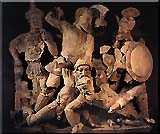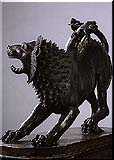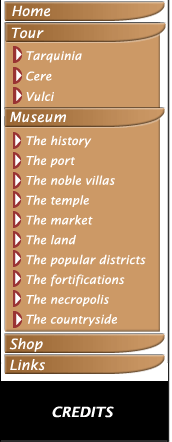|

Religion
At the basis of the Etruscan religion there lay the fundamental
idea that the fate of men was completely decided by the gods,
mysterious and undefined supernatural beings. All natural
phenomena, such as thunder or the flight of birds, were therefore
an expression of divine will and contained a message to be
interpreted in order to comply with the wishes of the gods.
With this conception as their driving force, the Etruscans
built up a complex system of codified ritual that they followed
with extreme scrupulousness, to the extent that they became
famous with other ancient peoples for their religiousness.
From the 8th century BC, as contacts with Greek culture became
more intense, there began a process of harmonization with
the divinities of the Greek Olympus. However, this process
did not lessen the specificity of the religious sentiment
of the Etruscans and the sense of complete annulment of man
before divine will.

Priests
The priests were the guardians of the doctrine and intermediaries
between men and the gods. This caste played a very important
role in the civil and religious guidance of the Etruscan communities.
The priests had a particular costume, including a high semi-conical
hat, and carried a stick curved at one end. They were divided
into counsels and took part in all public activities, which
for the Etruscans had a strong sacred significance. The scriptures
consisted of books containing a complex and codified system
of ritual rules. The main ones concerned: the interpretation
of the entrails of animals, carried out by the Haruspices,
the interpretation of lightning, carried out by the Augurs
and the rules of behaviour to be followed in daily life. At
the basis of Etruscan religious discipline was the division
of the heavens into sixteen compartments: the dwelling-places
of the gods. The favourable gods were in the east and the
unfavourable ones in the west. Thus, as far as divination
is concerned, every atmospheric event could be translated
into a message from the divinity who dwelled in that place.
Depending on the event, it could be an order, a good or an
evil omen, or a sign of anger or discontent. This system of
compartments was also reproduced on the livers of sacrificed
animals, of which bronze models have come down to us: the
will of the gods was deduced from the observation of their
physical characteristics.

Religious
architecture
The Etruscan temple, for the building of which precise rules
were established, was characterized by an almost square floor
plan. The front half consisted of a gallery with columns,
the rear half was occupied by three chambers, which housed
the statues of three divinities or by a single chamber flanked
by two open wings. Except for the basement and foundations,
light and perishable materials were used: unbaked bricks for
the walls and wood for the structure. The temples had very
wide and low double sloping roofs, with considerable lateral
projection and the façade was dominated by an open
or closed triangular fronton. The roof was completed by a
complex system of terracotta decorative and protective elements,
painted in bright colours and in full relief. These elements
included the acroteria, which were placed on the top of the
temple and at the corners of the sloping roofs, and the antefixa,
which were positioned on top of the roofing tiles.

Etruscan
art
Art for the Etruscans was always linked with daily life and
had a practical more than an aesthetic purpose, to the extent
that it is often referred to as artistic handicrafts. The
Etruscans drew the majority of their subjects from Greek art,
but they reworked them in more immediate, popular and decorative
expressive forms. It was therefore a spontaneous art, which
aimed at intensity of expression even at the cost of deforming
natural reality. As far as painting is concerned, we have
to talk of sacred art, as the paintings that have been found,
the greatest number in the tombs at Tarquinia, are those which
decorated the walls of the burial places.
Two
distinct phases can be distinguished in pictorial representations.
The first is characterized by extremely realistic representations,
with the aim of giving a vital message with banquets, games,
athletic contests and dances. These are serene and pleasant
episodes, with decorative elements reconstructing the domestic
environment. The second period became established between
the 5th and 6th centuries BC, when the idea of the transmigration
of the soul to the kingdom of the dead became popular. Mythological
scenes then began to be dominant, with images evoking the
world beyond the tomb and the demons that lived there. Etruscan
painting usually tended to perpetuate standardized patterns,
produced by painters who were skilful craftsmen rather than
artists.
Typical features are the centrality of the human figure which
dominates the setting; the use of solid and strong colours,
which fill in areas outlined by thick lines using the fresco
technique. For sculpture too, we have to talk of sacred art,
as the discoveries consist of decorative elements of temples
or tombs. Etruscan sculpture is closely linked with the modelling
of clay. Stone sculptures also show traces of this fundamental
technique and Etruscan sculptors indeed preferred working
with soft stones. Etruscan sculpture is distinguished by the
total absence of formal research. It is not of any value in
itself as a work of art, but is of value for the practical
meaning that can be given to it. The Etruscans were famous
amongst their contemporaries for their bronze sculptures,
which they produced using special casting processes. Although
not much has come down to us, only some unique pieces such
as the Chimera of Arezzo, the Capitoline she-wolf and the
Haranguer, we can get an idea from these of a finely advanced
art which remains a total mystery for us.
|



